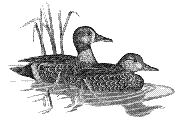United States Fish and Wildlife Service

Waterfowl Management Handbook
Date of this Version
January 1992
Abstract
Between 25,000 and 30,000 playa lakes are in the playa lakes region of the southern high plains (Fig. 1). Most playas are in west Texas (about 20,000), and fewer, in New Mexico, Oklahoma, Kansas, and Colorado. The playa lakes region is one of the most intensively cultivated areas of North America. Dominant crops range from cotton in southern areas to cereal grains in the north. Therefore, most of the native short-grass prairie is gone, replaced by crops and, recently, grasses of the Conservation Reserve Program. Playas are the predominant wetlands and major wildlife habitat of the region.
More than 115 bird species, including 20 species of waterfowl, and 10 mammal species have been documented in playas. Waterfowl nest in the area, producing up to 250,000 ducklings in wetter years. Dominant breeding and nesting species are mallards and blue-winged teals. During the very protracted breeding season, birds hatch from April through August. Several million shorebirds and waterfowl migrate through the area each spring and fall. More than 400,000 sandhill cranes migrate through and winter in the region, concentrating primarily on the larger saline lakes in the southern portion of the playa lakes region.
The primary importance of the playa lakes region to waterfowl is as a wintering area. Wintering waterfowl populations in the playa lakes region range from 1 to 3 million birds, depending on fall precipitation patterns that determine the number of flooded playas. The most common wintering ducks are mallards, northern pintails, green-winged teals, and American wigeons. About 500,000 Canada geese and 100,000 lesser snow geese winter in the playa lakes region, and numbers of geese have increased annually since the early 1980’s. This chapter describes the physiography and ecology of playa lakes and their attributes that benefit waterfowl.


Comments
Published in Diana H. Cross and Paul Vohs (eds.) Waterfowl Management Handbook. Fort Collins, CO: U.S. Fish and Wildlife Service, 1988. Online at http://www.nwrc.usgs.gov/wdb/pub/wmh/contents.html